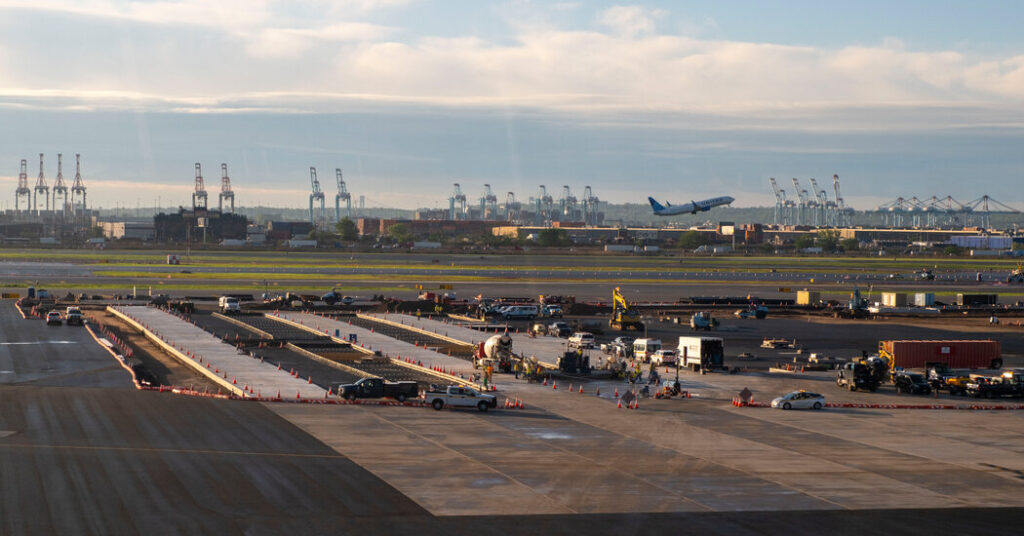An air traffic control facility that guides planes at Newark Liberty International Airport had a brief radar outage on Friday morning, the latest technological disruption at one of the nation’s busiest airports.
The outage, which affected communications and radar displays at a facility in Philadelphia, occurred just before 4 a.m. and lasted about 90 seconds, the Federal Aviation Administration said.
A similar 90-second outage last week, on a Monday afternoon, upended travel at the airport, leaving controllers unable to communicate with pilots and keep planes from crashing into one another. Several controllers working that afternoon were distressed by that episode and took time off, which resulted in several days of low staffing at the facility, causing widespread flight delays and cancellations.
The problems at Newark and other aviation safety concerns have become a major challenge for President Trump. Just days after he took office, an American Airlines plane crashed into an Army helicopter near Ronald Reagan National Airport in Washington, killing everybody aboard both aircraft.
Karoline Leavitt, the White House press secretary, told reporters on Friday that a “glitch in the system” had been caused in the morning by “the same telecom and software issues that were raised last week.”
“Everything went back online after the brief outage, and there was no operational impact,” Ms. Leavitt said. Federal transportation officials “are working to address this technical issue tonight, to prevent further outages,” and are planning to install new fiber-optic cables from the Newark airport to Philadelphia, she said. The goal is to have the system fully upgraded by the summer, she added.
On Thursday, the transportation secretary, Sean Duffy, announced a plan to modernize and overhaul the country’s air traffic control system. The proposal, which will cost billions of dollars, includes investing in new technology and facilities. But many details remain unclear, and the plan will require approval from Congress.
The latest outage on Friday is likely to intensify pressure on administration officials and lawmakers to act.
An air traffic controller directing traffic at Newark early Friday mentioned the latest outage to the pilot of FedEx Flight 1989 when it occurred, according to a publicly available recording of air traffic control communications with pilots.
“FedEx 1989, I’m going to hand you off here — our scopes just went black again,” the controller said. “If you care about this, contact your airline and try to get some pressure for them to fix this stuff.”
“Sorry to hear about that,” the pilot replied.
In a separate exchange, a controller told another pilot about the outage and instructed the pilot to maintain distance if the pilot could not reach the controller.
ABC News reported on the outage earlier.
Flights to and from Newark were delayed on Friday morning. The F.A.A. also initiated a “ground delay program,” which remained in effect midday. It held flights destined for Newark at their origin airports by an average of more than four hours because of rain in and around New York City. The Newark airport is a roughly 17-mile drive from Midtown Manhattan.
A spokesman for the Port Authority of New York and New Jersey, which operates Newark, said the outage did not affect passenger operations at the airport.
Newark has long had problems. The F.A.A. had recently hoped to address a staffing shortfall among air traffic controllers last summer by moving some operations for Newark from Westbury, N.Y., on Long Island, to Philadelphia. Controllers at the facility in New York had fought the relocation, but the F.A.A. said it could recruit more controllers by moving the work to a more affordable area.
About 10 percent of flights to and from Newark were canceled from the start of last week through Wednesday, according to data from FlightAware, a flight tracking service. The two other airports serving the New York region fared much better. Over the same period, only about 2 percent of flights were canceled at LaGuardia Airport and 1 percent at Kennedy International Airport. Newark also saw far more delays than the other two airports.
The disruptions are particularly frustrating for United Airlines, which counts Newark as one of its eight airport hubs and dominates traffic there. More than two out of three flights to and from the airport are sold by United. A variety of airlines account for the remaining flights, according to Cirium, an aviation data firm.
In an email to employees this week, United’s chief executive, Scott Kirby, said flights to and from the airport remained safe. Newark is a “crown jewel of the region,” he said, but the airport is overwhelmed, with more flights scheduled on most afternoons and evenings than the F.A.A. has said it can handle.
“This math doesn’t work,” he said. “Especially when there is weather, staffing issues or technology breakdowns — the airspace, taxiways and runways get backed up and gridlock occurs.”
To solve the problem, Mr. Kirby said, the F.A.A. should reverse a 2016 decision that loosened limitations on the number of flights scheduled at the airport in an effort to promote competition at Newark.
At highly congested airports around the world, including Kennedy and LaGuardia, aviation authorities may choose to tightly control the number of opportunities to take off and land, known as “slots.” Newark was similarly slot-controlled, but the F.A.A. relaxed those restrictions in 2016.
At the time, United had been accused of holding on to, but not using, some slots in order to maintain its dominance at the airport, which has remained mostly unchanged. The airline criticized the decision in 2016, saying it would further strain the New York airspace. The F.A.A. still reviews flight schedules at Newark, but it no longer limits and assigns slots there.
Michael Levenson, Neil Vigdor and Patrick McGeehan contributed reporting.



